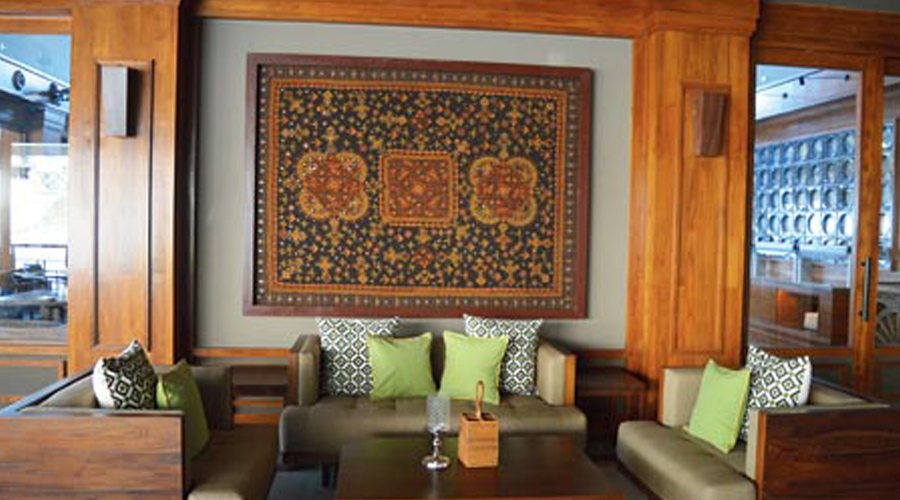One of Harshavardhan Neotia’s self-admitted interests in building hotels lies in paying obeisance to nature, which only needs one to simply take a look around any of his said creations that are undoubtedly always of stunning architectural design, melding outdoor beauty with great interiors and of course art — and lots of it. Thus as I met him at The Chambers, Taj Bengal, on a crisp, winter morning over some black coffee (freshly brewed, he specifies), it absolutely made sense when he said that his brief to his architects for all his projects is to never stand out or be loud in design.
Having just visited Taj Chia Kutir, Darjeeling that has been built by the Ambuja Neotia Group and is run by Indian Hotels Company Limited (IHCL), I can vouch for the magnificent art at the property that I fell in love with before I could even reach my room.
Neotia chatted hotels, art and his association with IHCL that is set to gift the eastern region a bouquet of four more properties soon, including two in the city. Excerpts:
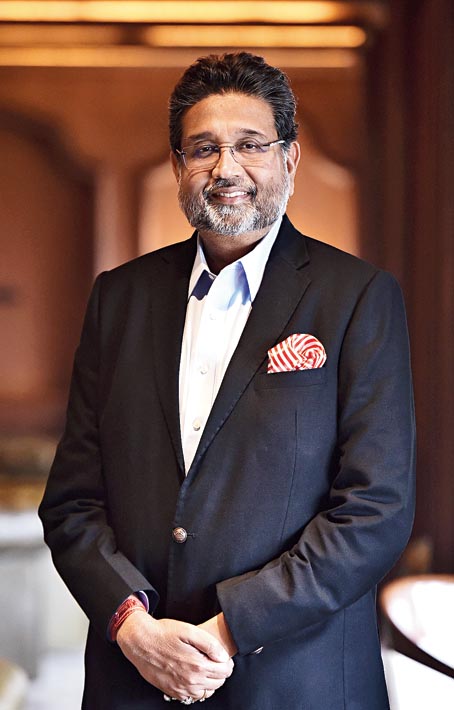
Harshavardhan Neotia, chairman, Ambuja Neotia Group. Picture: B. Halder
How did your interest in the hotel sector begin?
There are three parts to this. First because I am born and brought up in Bengal and I have travelled to many of these places as a tourist, I realised that the beauty of the eastern Himalayas and many parts of Bengal are extraordinary. But because high-quality infrastructure is not available, a lot of my friends living in other parts of India never visited or didn’t even think of visiting due to questions like where would they live. This beauty is unique and I am sure anyone who wants to visit such places in India would want to come here so this was one trigger. Second is that I have this great interest in design and therefore, for me, hospitality is the last frontier in architectural and physical design because you’re also doing interiors, experiences and designing how a place will be used, as opposed to just making shopping malls or offices. The third — what is a temple? You create a space where you feel that there’s a special energy and that energy is in the form of an idol, a lamp or some kind of a symbol. As much as man interprets that energy as a field in which god resides, these mountains, rivers, oceans and jungles are god’s creations and divinity also lies there. So I said what we need to do is to create these modern rest houses where we can witness the magic of god.
There were two principles that I briefed my architects on — all our projects should pay obeisance to nature in a sense and therefore it should be a little silent, comfortable but not loud. So that it did not distract me from what I was there for and I would assume that most people would go there to enjoy or witness the outdoors in the daytime. For the nighttime, I wanted to make it a little inward-looking — cosy, warm and therefore the warm colour palette and the lighting. While there’s a sense of expansion by the day, there’s a sense of contraction by night. That was very deliberate in the sense of design — you expand yourself when you wake up in the morning and then you cocoon yourself when you retire for the night.
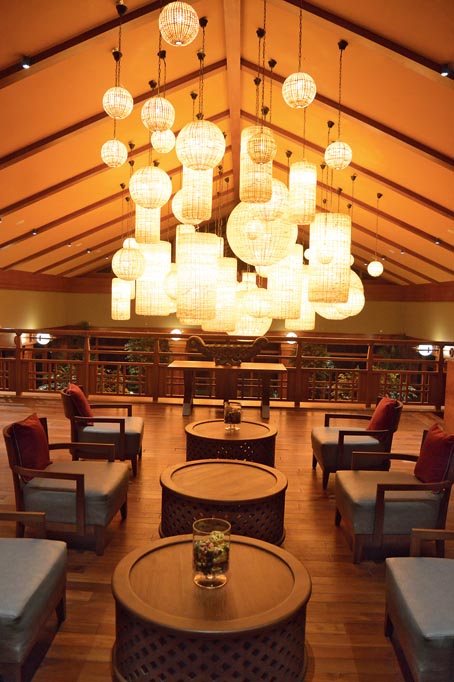
The statement lights at the lounge area
How did your association with IHCL happen?
I was at a conference in Delhi when we had already started work on these new developments and were looking to run it ourselves. But some of our colleagues and consultants were saying that it would take a very long time for me to establish the branding and positioning than how an established brand would do and I was worried about finding a partner that could relate to what we were doing. I had a chance meeting with the head of IHCL about five-six years ago and shared this idea. The team came to visit and I felt we were on the same page so we tied up for the two hotels we were doing in Sikkim and Darjeeling. What we were doing was compatible with what they were doing and we respected each other. The other hotels came in naturally as we already had a relationship. And everyone in my team got along with their’s.
How did Taj Chia Kutir happen? What was your involvement in this project like?
One thing was certain that I wanted to do a project up in the hills and I wanted to do something in the tea gardens. Being in the middle of Darjeeling would not work for the up-end tourist and I needed to be at a place that was a little secluded. Fortunately, there was a tea tourism policy and then it was a no-brainer that Makaibari was the most famous Darjeeling tea. I met Rajah Banerjee of Makaibari in 2010 (it is now run by Rudra Chatterjee) and we were on the same page as it would enhance his brand too. As it happened, this probably was the first project under the tea tourism policy then — the government had a policy but nobody had implemented it so it took about six years to get all the permissions. We had another hiccup in the form of the agitation in the hills when work was stopped completely for about seven months. Initially we were a 40-room hotel and then we were persuaded by Taj to be a little bigger and now we are at 72 keys and that also halted the work for a bit as it required some replanning.
About the architecture of the place and my involvement in it, I was very clear that it should be something that was very muted so it disappeared into the landscape and did not stick out like a sore thumb amidst the greenery. So every time something white was being put in, I would tell Kapil (Bhalla, the architect), “Please put brown or grey. Don’t put white!” I just wanted it to disappear because if someone goes to see the fantastic natural beauty there, why would they want to see the house? I wanted it to be as unobtrusively visible as it could be. It had to be an understatement at its best and that was my brief to Kapil.
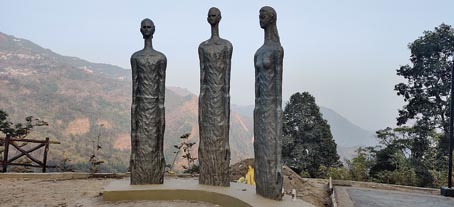
Three abstract figurines that find place on one of the gardens at Taj Chia Kutir to lend dimension to the landscape.
Your personal interest in art lends itself to the property…
For me, design is not something that I have been trained in but it’s something that I have experienced growing up as my home was full of art and all the folks in my joint family had interest in some cultural aspect of the arts. So I had artists, scholars and musicians walking in and out of my house as I grew up. It was a symbiotic assimilation of all these influences that came in involuntarily. I used to paint a little, pottered around my garden and did a little landscaping as a teen as fun stuff.
Our family was never involved in construction till then and it just so happened that when I was 22, I got an opportunity to build a small apartment complex that happened by fluke. I trained under Shyamanand Jalan (thespian) for the first two years as he was my uncle’s (Suresh Kumar Neotia) school friend and was into building — he did not work after 6pm and we often ended up at Padatik (laughs).
I think all these symbiotic influences were in me without any formal induction into the arts. And I found them appearing in my work somehow. Sometimes I would see Mr Doshi (architect B.V. Doshi) and Mr Correa (architect Charles Correa) wondering how I was solving some of these problems and thinking I was consulting someone else, which I wasn’t. But I did get a lot of encouragement from them as they appreciated my interventions despite being masters in their fields. Mr Doshi was a benevolent, professorial person who encouraged debate but Mr Correa could be an extremely difficult person so for him to even allow me to suggest something was a great honour for me. I felt relieved because if these people were accepting some of my suggestions, they could not be doing it only out of courtesy as they could not care less! That’s when I thought of building more.
The art in all my projects is very seldom thought about at the beginning. We first look at the form and function from a very fundamental point of view and then we say we will in-fill it. Then there’s stuff lying at home — like I had about 20 photographs (by Stuart Freedman) of this tea series featuring an eclectic mix of photos from tea houses all over India that I had picked up from this exhibition and those went to the mezzanine floor of the lounge.
We used illustrations from a book (Victor Halfwit — A Winter’s Tale by Thomas Bernhard, illustrated by Sunandini Banerjee) for one of the corridors and this was picked up about 10 years ago. When we were thinking about something quirky and interesting, we decided to put this up. The two flowers on the bed- back are by this young artist (watercolour flowers by Gouri Bhakta) and were commissioned by me when I had gone to ArtsAcre recently. I took a photograph and sent it to Kapil and then asked the artist to make 150 pieces in six months. We used sepia-tinted historical pictures of Darjeeling for the rooms too. The kantha and fabrics were all at home (framed textile art by Rahul Jain and other patchwork kantha from his family collection) and there’s some more coming. The terracotta mural at the reception is a commissioned piece from Bankura, while the ceramic murals at Chia Veranda have blown up, abstract photographs of an elephant.

Pages from Victor Halfwit — A Winter’s Tale by Thomas Bernhard, illustrated by Sunandini Banerjee adorn one of the corridors of the property that arrests attention of guests

Pages from Victor Halfwit — A Winter’s Tale by Thomas Bernhard, illustrated by Sunandini Banerjee adorn one of the corridors of the property that arrests attention of guests
So what’s your personal favourite spot at the property?
I think I have visited about 30-40 times and I don’t have a favourite spot yet because every visit has been so hectic and packed with so much work. There has not been a single day yet when I have been able to put up my feet and relax. I think ultimately, it will be the verandah of my room because I would need the privacy, from the private retreat point of view. I have put in a small storeroom in one of the suites that has access from the outside as well so I can leave my belongings there. The weather is always very temperate and I have made a generous-sized balcony there because being at Makaibari for me means being outdoors. I’ll probably spend a very large part of my time there.
What according to you is the unique selling point of the property for guests?
The fact that the property sits on the very beautiful landscape of the Makaibari tea estates, with magical sunrises and sunsets, is one part. In terms of amenities and comfort, we have tried to provide a reasonably comprehensive product with a heated swimming pool, a great spa, music by the night, tea-tasting, tea trails, picnics, a kids’ area that is coming up and even a day’s visit to Darjeeling, river-rafting or some boating at Mirik for people who come for longer. People who come for two-three days do not need to leave the property as there’s enough to do and different kinds of food too.
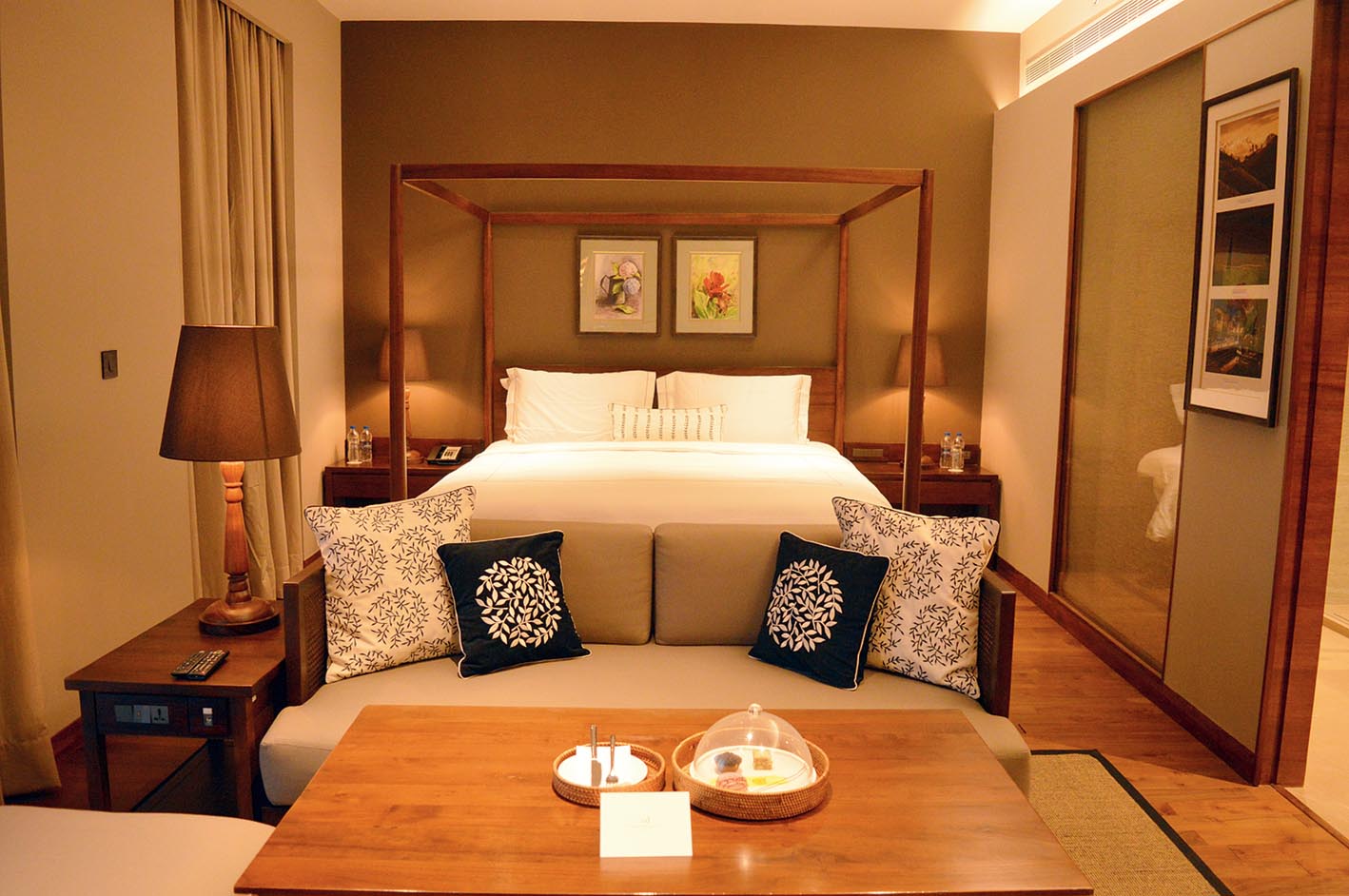
Watercolour flowers for the bed-backs by Gouri Bhakta that was commissioned by Neotia
What can we expect from your other properties coming up at Sikkim and Patna in conjunction with IHCL?
One can expect a lot of commonality in features (amenities and facilities) with Taj Chia Kutir but in terms of architecture, aesthetics and design, it will be different. We have a different team for that and the topography is different with a beautiful mountain view. We might not have a swimming pool there but we have a generous Jacuzzi. We need to be mindful about the water challenges at these mountains so we haven’t provided bathtubs as water is scarce.
The Bihar property is much like a business hotel. Of course there will be a lot of art but it will be like a city hotel — a lot like the new Taj property coming up in Rajarhat. The hotel building is ready and now we have to start with the interiors. The properties at Sikkim and Patna will have very different emotions.
So when can we expect your city affiliations with IHCL coming up?
There are three products — a convention centre that is almost ready and we are hoping to hand over to Taj by March, a new Taj at Rajarhat that we are looking at a pre-Puja opening and a suite hotel next to the convention centre, which we have pushed back a little due to the pandemic.
You opened Taj Chia Kutir in the middle of a pandemic, offering people an escape to the hills. What were some of the challenges and how has the response been?
All our businesses were impacted and there was a lot of pressure but that is not unique to only us and is true for everyone in our sector. The lockdown and the consequent fear made it impossible for workers to restart because of logistical reasons. We should have opened this hotel in April but we opened in December so we definitely lost time. It became so much more expensive to work when things started opening after the lockdown. But we managed to finish it.
About the response, I think Modhurima (points at Modhurima Sinha, director, PR, east, IHCL; seated next to him) is better equipped to answer this — [“The response has been phenomenal! Of course the post-pandemic part is one thing because people were wowed that something like this opened up in this part of the country at a time like this that people can go to from anywhere and especially from Calcutta. It’s the combination of the presentation, the product and the brand association that have all taken off in a stunning way,” said Modhurima.] Of course the credibility of the brand also helps in creating the trust, the network and loyalty.
What is your prediction for the hospitality sector with vaccines now rolling out and people looking to get back to normal with precautions?
This has been a fundamental debate. A lot will shift and of course on the business side, there will be a lot of resetting. I don’t think business travels and meets will be the same because a lot of things that we didn’t imagine we could do digitally will now be possible. But I think there will be a strong bounce-back on the leisure side, including the social things like weddings. I believe we are all fundamentally social people and have been locked up because of the pandemic but who wants to do that? So my question is that would you not want to do it again as soon as it is safe? You would want to go out and meet people and enjoy the beauty of nature once again. Leisure hotels have already started demonstrating that and city hotels will soon follow suit though business will take a little bit of hit. But it will be more than compensated for by social and leisure; and business travel will also get back eventually because the Zoom fatigue is hitting all of us.

